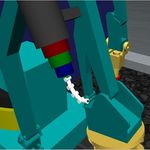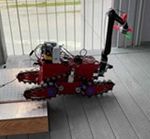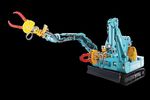Team Activity of Robot Competition of Simulated Robot in World Robot Summit 2020
←
→
Page content transcription
If your browser does not render page correctly, please read the page content below
SHS Web of Conferences 102, 04016 (2021) https://doi.org/10.1051/shsconf/202110204016
ETLTC2021
Team Activity of Robot Competition of Simulated Robot in World
Robot Summit 2020
Daichi Shima1, Tomoyuki Furukawa1, Ryuma Aoba1, Ayato Ohashi1, Kota Tsuruno1, and Keitaro Naruse1*
1The University of Aizu, Department of Computer Science and Engineering, Aizu-Wakamatsu, Japan
Abstract. World Robot Summit (WRS) has several robot competitions, and we will participate it in the
infrastructure and disaster response category. Participating teams develop their robot system by tele-
operation and/or autonomous operation and run it in a set of courses modelling and simplifying disaster
responding situations. The authors will attend the challenge of the tunnel disaster response and recovery, in
which we are requested to achieve an investigation and rescue scenario of a tunnel fire with simulated robots.
As preparation, we develop simulated robot models and corresponding software as a team. In this article,
we report out activity to the robot competition and student’s project-based learning by joining it.
1 Introduction
Generally. Robot simulation is used to check what kind
of problems will occur in advance with a computer
before an actual robotic system is operated in a real
workspace. In addition. It is also used for training of new
robot operators, as well as designing to test robot
structure and motion before we build it physically.
In our laboratory, we have developed the actual
disaster response robot as shown in Fig. 1 and Fig. 2, as
well as corresponding simulated robot as in Fig. 3 and Fig. 2. Simulated robot model of Spider 2020.
Fig. 4. We use the simulated robot mainly for
developing robot software before implementing to the
actual robot.
On the other hand, for open innovation of robot
technologies, robot competitions have been held
worldwide. We are registered and will join to the
infrastructure, and disaster response category in World
Robot Summit 2020 (WRS2020) [1], which is
postponed in the next year due to COVID-19.
In this paper, we report on our activity for the
competition by the simulated robots as an instance of
project-based learning in robotics.
Fig. 3. Large disaster response robot named Enryu.
Fig. 4. Simulated robot model of Enryu.
Fig. 1. Small disaster response robot named Spider 2020.
*
Corresponding author: naruse@u-aizu.ac.jp
© The Authors, published by EDP Sciences. This is an open access article distributed under the terms of the Creative Commons Attribution License 4.0
(http://creativecommons.org/licenses/by/4.0/).SHS Web of Conferences 102, 04016 (2021) https://doi.org/10.1051/shsconf/202110204016
ETLTC2021
2 Development Investigation around, inside, and outside of the vehicle;
breaking down doors; investigation and rescue of people
For attending the robot competition by simulated robots, in need of help (Fig. 5).
we have been working on both model and software Points:
development as a student team. Here we present our Can the robot perform a visual inspection in a small,
tools and process of development. intricate, and dark place? How carefully can it handle
the human body?
2.1 Development environment
(2) Securing the route
Table 1 shows our development environment of
simulated robots. We use the robot simulator called Tasks:
choreonoid [2], which is designated by the regulation of Moving obstacles out of the path, trans-shipment, stick
the competition, under a recommended OS of Ubuntu pulling, preparing for blasting (Fig. 6).
18.04 LTS. The simulator introduces a numerical Points:
calculation engine named AGX Dynamics [3] for robot How to handle an L-shaped obstacle with an unknown
motion dynamics. canter of gravity.
We develop our software mainly by C++ language
with linear algebra SDK called Eigen [4], and some
tools are implemented in Python. As communicating
with other services, we use the robot middleware called
ROS [5]. We introduce github [6] for code sharing and
Google drive for other document sharing.
We employ a gamepad named dual shock 4 for
operating the simulated robots.
Fig. 5. Task (1) Investigation and rescue of vehicles and
Table 1. Development environment of simulated robots. surroundings.
OS Ubuntu 18.04 LTS
Programming C++, Python
Languages
Simulator Choreonoid
Middleware ROS (Robot Operating System)
Dynamics engine AGX Dynamics
SDK Eigen
Code share Github, Google drive Fig. 6. Task (2) Securing the route.
Other devices Dual Shock 4
2.2 Development process
We mainly operate Choreonoid through ROS interface.
First, we develop a robot model using CAD or other
tools. Then we develop the software to control the model
according to choreonoid SDK and check the simulation Fig. 7. Task (3) Firefighting work.
feasibility on it. After that, we check the coordination
with external visualizer with ROS interface and
complete the development.
3. Task and Problem
In this section, we describe instances of courses and
required functionalities of the simulated robots, showing
those in the stage gate qualification of WRS2020.
Fig. 8. Task (4) Inspection of the tunnel wall and ancillary
equipment.
3.1 Task
For tasks, there are four tasks that respond to tunnel (3) Firefighting work
disasters. Tasks:
Hose withdrawal, hose and nozzle connection, valve
(1) Investigation and rescue of vehicles and operation, digestion (Fig. 7).
surroundings Points:
Ability to handle a variety of digestion tasks (e.g.,
Tasks: handling of hoses as flexible objects, connection of
2SHS Web of Conferences 102, 04016 (2021) https://doi.org/10.1051/shsconf/202110204016
ETLTC2021
nozzles and hoses, etc.), ability to deal with the reaction As a result, we are able to solve most of the problems
force of water discharge. in task 4. However, it is still difficult to adjust the
camera to find and focus to a QR code only looking at a
camera image. We are currently developing a robot arm
(4) Inspection of the tunnel wall and ancillary
controller to solve it.
equipment
Tasks: 4 Activity
Checking jet fan bolts, tunnel wall and road surface
Point: WRS2020 was scheduled to be held in July 2020, but it
Is there a large space capable of handling the inspection was postponed due to COVID-19, and it is now
of the walls of the tunnel itself and ancillary equipment scheduled to be held in May in the next year. Therefore,
such as jet fans? (Fig. 8) we have organized a demonstration event by us in
October in this year, for demonstrating our robot model
3.2 Problems and controller, and handing them over to team members
in the next year.
Most of the tasks can be solved by our first robot We have made two teams: the first team is made by
models. However, the following two issues are required fourth-year students and the other one is by third-year
to develop a new robot model. We have solved it by students in our university.
developing a new camera device called the end-scope The demonstration event is composed of two phases:
camera. The first one is offline challenge. We have organized a
review committee separated from participating teams.
The committee has created a set of courses, opened it in
First issue:
github, asked the participating teams to challenge them
In the task 1 and task 4, there are many cylindrical by their PCs and to submit the result.
objects, and at the end of them, there are QR codes The other one is online symposium by the teams to
which are required to be viewed and decoded by the share their experience, which is done with zoom.
camera mounted on the robot. They needed to be seen
and read by a camera mounted on the robot, a task that 4. 1 Offline challenge
was nearly impossible with the existing robot model.
In the challenge, it is required to perform tele-operation,
which means a robot operator can only observe a
Second issue
workspace from a set of cameras attached to a robot and
In task 4, it is difficult to extend the arm up to the QR cannot see a perspective view of a workspace.
code present in the top of the jet fan due to the robot size. We have designed two courses as follows with less
On the other hand, we can introduce a drone to measure difficult than the WRS courses because we have less
it, but it is also difficult to read the QR code from it due experienced team in this event.
to position stability. (1) Stage-Gate 1 for large robot
Tasks: Operating a large-size simulated robot to go
through a narrow room without colliding with obstacles
3.3 Solution (Fig. 10).
(2) Stage-Gate 2
To solve the above problems, we introduced an idea of
Tasks: Operating a large-size simulated robot to pushing
an end-scope camera as seeing 365-degree view, which
a L-shaped obstacle to be aligned at a designated area
is shown in Fig. 9. It has four joints, which are controlled
(Fig. 11).
independently. In addition, we have developed a robot
arm controller with inverse kinematics, which allows us
to move a hand tip to designated position automatically.
Fig. 10. SG1L course.
Fig. 11. SG2 course.
Fig. 9. End-scope camera (White device).
3SHS Web of Conferences 102, 04016 (2021) https://doi.org/10.1051/shsconf/202110204016
ETLTC2021
focused on the operation and development of the
system. We were able to clear most of the tasks. As for
future activities, we proposed that we will focus on
handing over the technology to junior members.
4.2.2 Learning effect of the team of 3rd grade
students
The team of third-year undergraduates spent about a
month preparing for the demonstration, focusing on the
activities of the operators and participating as a new
team in preparation for the WRS, which is scheduled to
Fig. 12. Snapshot of task challenging. take place next year. They presented the improvements
of the current system and user interface as an operator in
the presentation of their results and presented their goals
and improvements for the WRS.
4.2.3 Learning activities among students
At the online symposium, we consider the handing over
of technology to the younger students to be the most
important thing, so we hold a study session focusing on
choreonoid and ROS among the students. Specifically,
they are taught how to create models and development
procedures.
Fig. 13. Operator’s screen.
To ensure that there are no irregularities in the task 5 Conclusion
attack, the operation PC and the monitoring PC are
separated, with one person acting as operator and one as In this paper, we have reported our activity of
supervisor. On the operation PC, a user interface development and team training as an instance of project-
utilizing the ROS feature Rvis is used to control the based learning in robotics.
entire operation. The monitoring PC observes the entire
field using choreonoid and monitors it for judging if the References
task is performed well. A snapshot of task challenging,
and operator’s screen is shown in Fig. 12 and Fig. 13, 1. Tunnel Disaster Response and Recovery
respectively. Challenge in World Robot Summit 2020,
https://worldrobotsummit.org/en/wrs2020/challeng
4. 2 Online-symposium e/disaster/tunnel.html
2. Choreonoid, https://choreonoid.org/ja/
We have two teams joined in the offline challenge. On 3. AGX Dynamics, https://www.algoryx.se/agx-
the other hand, for open innovation of robot technology, dynamics/
we should have an opportunity to share experience of
teams joined in the offline challenge. Therefore, we 4. Eigen, http://eigen.tuxfamily.org/
have arranged an online symposium by team members, 5. ROS, https://www.ros.org/
competition officials, who has designed the offline 6. Github, https://github.com/
challenge course, and several experts on robot simulator
for giving valuable comments to the team members.
In the symposium, we have two student teams, and
they have presented their strategy to attack the
challenge, have showed their video of challenging, and
have given comments from attendees.
On the other hand, a whole process of students’
activity can be regarded as a project-based learning.
Process (PBL). We will summarize comments from the
students as follows.
4.2.1 Learning effect of the team of 4th grade
students
The fourth-year undergraduate team had formed for
WRS2020, which was scheduled for this year, and was
4You can also read



























































